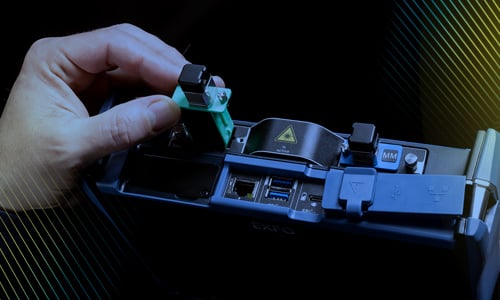From quick checks to deep dives: OFM or OTDR, the right tester for the right job
From quick checks to deep dives: OFM or OTDR, the right tester for the right job
In today’s advancing world of telecom, fiber-optic networks have become the backbone of digital technology. Whether you're laying down new fiber lines or maintaining existing networks, choosing the right optical tester for the right job can be as daunting as doing the troubleshooting. While reflectometry-based instruments are designed to assess and ensure the health of fiber optics, testers like the optical time-domain reflectometer (OTDR) and the optical fiber multimeter (OFM) serve distinct yet complementary purposes and are suited to different scenarios.
To illustrate this in lay terms, let’s draw a parallel with our use of a fridge and freezer. Both rely on refrigeration technology but just as you wouldn’t store ice cream in the fridge or keep fresh milk in the freezer, the choice between OTDR and OFM can be broken down likewise and explained.
In this blog post, we’ll guide you to make an informed decision on when to use each instrument.
When quick and high-level verification is key
The OFM provides a high-level health check that is both quick and efficient. When does this come in handy?
1. During initial activation: When activating fiber-to-the-home (FTTH) services, time is of the essence. The OFM swiftly confirms whether the fiber link is operational. It provides a quick health check and a high-level assessment for fiber readiness—simple, fast and very effective.
2. Routine maintenance checks: For routine checks to ensure everything is running smoothly, an OFM is the go-to tool. It is fit-for-purpose for technicians who need to run quick inspections regarding performance standards without getting down to the nitty-gritty.
3. Minor post-repair confirmation: After a minor repair, an OFM quickly ascertains the success of the fix. It can quickly measure and verify that the fiber link is back in action without the exhaustive analysis of an OTDR.
4. Day-to-day tasks for field technicians: The OFM is a tool that provides rapid results in daily tasks—delivering essential metrics like signal loss, optical power and optical link length, without overwhelming the technician with excess data.
When detailed characterization or .SOR file is non-negotiable
The OTDR, on the other hand, is specialized for in-depth diagnostics. It is the instrument of choice when a detailed assessment of the optical network is necessary.
1. New installations and comprehensive documentation: When a new fiber-optic network is laid out, creating a birth certificate with an OTDR is essential. This detailed report serves as a baseline for all future tests and comparisons. The OTDR’s capability to fully characterize the fiber is invaluable for this initial assessment.
2. Major post-repair analysis: After significant repairs or network topology changes, you need to ensure that the fiber's integrity is fully restored. An OTDR provides a granular look into the fiber's condition (splice loss, reflection, fiber length, new inventory) and delivers the metrics that are critical to confirm a successful repair.
3. Locating and diagnosing faults: When trouble strikes and you have a network fault, an OTDR is the technician’s best friend. It can pinpoint issues like breaks or macrobends with precision. An OTDR greatly helps to find and fix faults.
4. Maintaining historical data for long-term performance: For ongoing maintenance and performance assessment, the OTDR’s capability to save detailed .SOR files is essential. These records provide a traceable history of the fiber's performance over time, allowing for informed decision-making.
5. High-stakes environments: Whenever and wherever network performance is critical—and downtime is not an option—the OTDR’s comprehensive testing capabilities ensure that every aspect of the fiber is scrutinized and certified to meet stringent performance criteria.
Conclusion
While an OFM is a dedicated tool for quick assessments, the OTDR is an invaluable solution for comprehensive network analysis. These test tools are also complementary by nature—OFM for regular health checks and fast fixes, and OTDR for thorough, in-depth analysis and documentation. You need both in your arsenal for greater flexibility in your maintenance and troubleshooting strategies to ensure more robust and reliable networks.
EXFO’s comprehensive portfolio tailored to your needs
Here's a recap to quickly know when to use an OFM or an OTDR:
- EXFO’s Optical Explorer: For rapid, high-level assessments, routine checks and immediate post-repair confirmations. Learn more >
- EXFO’s OTDRs: For in-depth analysis, new installation documentation, complex issue diagnosis, and meticulous post-repair assessments. Whenever detailed .SOR files are required. Learn more >




